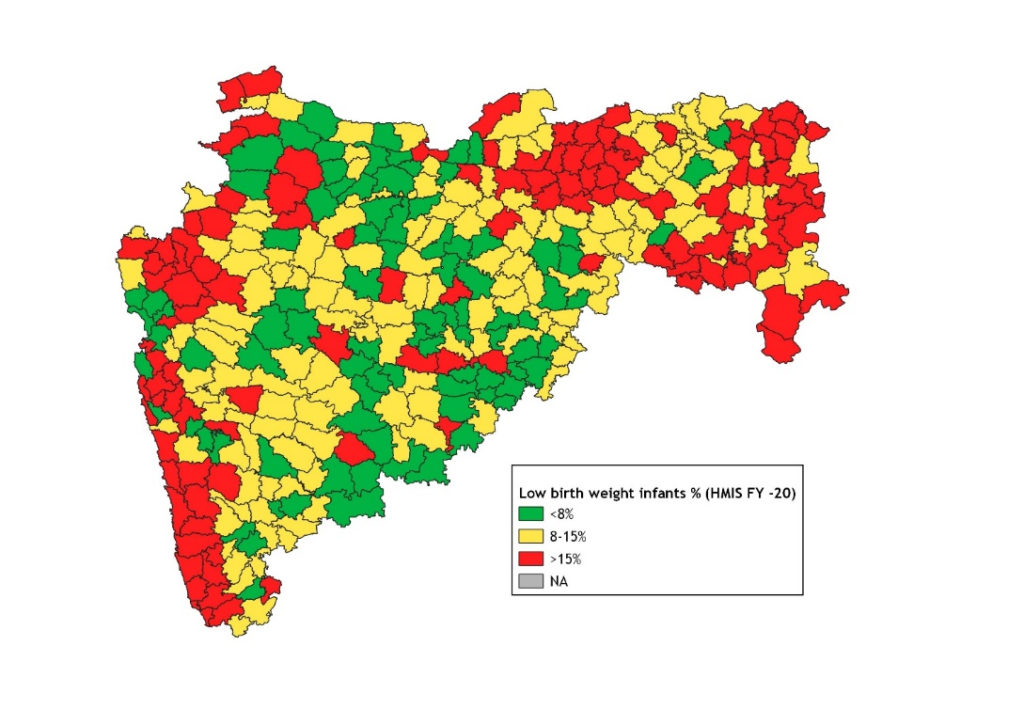The World Health Organization (WHO) defines low birth weight (LBW) as birth weight of less than 2500 grams irrespective of gestational age.1 In 2015, 20.5 million low birthweight babies were born globally, making up 14.6% of all babies and South Asia accounted for nearly half of these babies.2 LBW incidence is not only associated with increased neonatal mortality, and child malnutrition but also with increased risk of diseases that occur later in life such as diabetes, hypertension and cardiovascular diseases.3-5 Reducing LBW incidence hence would be critical to achieving SDG targets on child health and general well-being.6 In 2012, the 65th World Health Assembly passed a resolution promoting a Comprehensive implementation plan on maternal, infant, and young child nutrition which specified six global targets to be achieved by 2025 including a 30% reduction in LBW incidence.7
As per a recent study, 17.06% of infants in India were born with a weight <2.5 kg at birth in 2019-21 however incidence in Maharashtra was slightly higher at 18.9%.8 However, there is little information about the prevalence at district and block levels. The Health Management Information System (HMIS) is the only source that monitors critical health indicators below the state level on a monthly basis.
The current policy brief uses HMIS data from FY 2017-18 to 2019-20 to identify regions with the highest LBW incidence. The broader aim is to inform decision-making, including highlighting interventions that could reduce the incidence of LBW in the state.

Source: HMIS
Districts with the highest incidence of low-birth-weight babies?
Identifying districts that consistently have a high incidence of infants born with a weight below 2.5 kg is critical for targeted intervention. Between FY 2017-18 and 2019-20, high percentages of low-birth-weight infants were reported by 8 districts―Palghar, Amravati, Chandrapur, Nandurbar, Gadchiroli, Bhandara, Gondia, and Sindhudurg. However, Gadchiroli, Chandrapur, and Amravati featured among the five districts with the highest incidence over the three years. Chandrapur which reported the highest incidence in FY 18 reported a notable reduction of 6.5 percentage points between FY18 and FY20. In contrast, Jalgaon and Buldhana reported the lowest incidence in the state through the three years.

Source: HMIS
The color-coded maps highlight regional clusters during FY18 and FY20 (Figures 1 & 2). Several districts that reported a high incidence in 2017-18 also reported a high LBW incidence in 2019-20. The most prominent clusters of high incidences of LBW infants in FY20 were located in the northern and northeastern parts of the state. Two districts in southern Maharashtra also have high incidence. However, the patches of green showcasing low incidence that were largely located in the eastern part of the state have visibly changed to moderate incidence (yellow) since FY18.

Source: HMIS
Talukas with the highest incidence of low-birth-weight babies
Apart from identifying the districts that usually report higher births with weight lesser than 2.5kg, it is critical to identify the specific talukas or wards so that local administrators can initiate targeted action. The color-coded map highlights the talukas and wards that reported high (red), moderate (yellow) or low (green) percentages of births that had a weight lesser than 2.5kg in 2019-20 (Figure 3). Many talukas with high percentages of LBW infants were located in districts with high prevalence like Amravati, Gadchiroli, Chandrapur, Ratnagiri, and Sindhudurg. However, a significant cluster of high-incidence talukas was also found in districts Raigad, Nashik, and Yavatmal that reported moderate prevalence. In the year 2019-20, 6 of the 15 talukas or wards with the highest percentage of infants born with low weight (<2.5kg) in Maharashtra were located in districts with moderate prevalence (Table 1). Local administrators need to monitor these regions as well.

Source: HMIS
Reducing and managing LBW prevalence: Key Action Points
LBW significantly impacts child survival, health, and nutritional status.4-5 The long-term negative effects of LBW can be a hindrance to the state achieving SDG targets for child health and general well-being. However, lowering the incidence of low birth weight requires a comprehensive strategy that focuses on both the antenatal and post-natal periods.
Low birth weight (LBW) babies have a weight <2.5kg regardless of gestational age. It could be a result of preterm birth (short gestation <37 completed weeks), intrauterine growth restriction (IUGR) also known as small-for-gestational-age, or both.1,9 Evidence places emphasis on early detection and effective management of IUGR and preterm births.10 Evidence also suggests that improving maternal nutritional status can be beneficial.11 In the Indian context, there is evidence that anemic mothers are more likely to deliver LBW babies.12
Hence, it’s vital that antenatal care providers like ASHAs and ANMs ensure that all pregnant women receive the minimum antenatal care visits, calcium, iron & folic acid supplements, HB testing, and immunization as per guidelines. Additionally, the completion of routine ultrasonography to monitor fetal growth is essential.13
It is critical that health care workers provide health and nutrition education including counselling mothers to improve their diets, consume oral supplements in a timely manner, complete ANC visits, avoid risks such as smoking and alcohol use, and identify signs of preterm labor is vital.
Post-delivery, managing LBW newborns is critical. In high-priority districts, the Public Health Department must ensure that more health facilities include Kangaroo Mother Care (KMC) units as well as monitor whether the implementation in current health facilities is as per protocol.14
At home, ASHAs need to conduct periodic home visits to monitor child weight gain and counsel mothers to ensure adequate exclusive breastfeeding of LBW babies as per the home based newborn-care guidelines.15
References
- WHO. (n.d). Low birthweight (prevalence). Retrieved from: https://www.who.int/data/gho/indicator-metadata-registry/imr-details/76
- United Nations Children’s Fund (UNICEF) & World Health Organization (WHO).(2019). UNICEF-WHO Low birthweight estimates: Levels and trends 2000–2015. Geneva: World Health Organization.
- Negrato, C. A., & Gomes, M. B. (2013). Low birth weight: causes and consequences. Diabetology & metabolic syndrome, 5(1), 1-8.
- Kaushik, S. L., Parmar, V. R., Grover, N., & Kaushik, R. (1998). Neonatal mortality rate: relationship to birth weight and gestational age. The Indian Journal of Pediatrics, 65, 429-433.
- Jana, A., Dey, D., & Ghosh, R. (2021). Contribution of Low Birth Weight to Childhood Malnutrition in India. Research Square, 1-26.
- World Bank. (n.d.). Sustainable Development Goals and Targets.
- WHO.(2012). 65th World Health Assembly: Resolutions & Decisions. Geneva: World Health Organization.
- Singh, D., Manna, S., Barik, M., Rehman, T., Kanungo, S., & Pati, S. (2023). Prevalence and correlates of low birth weight in India: findings from national family health survey 5. BMC Pregnancy and Childbirth, 23(1), 1-13.
- Cutland, C. L., Lackritz, E. M., Mallett-Moore, T., Bardají, A., Chandrasekaran, R., Lahariya, C., … & Brighton Collaboration Low Birth Weight Working Group. (2017). Low birth weight: Case definition & guidelines for data collection, analysis, and presentation of maternal immunization safety data. Vaccine, 35(48Part A), 6492.
- Committee to Study the Prevention of Low Birthweight. (1985). Preventing Low Birthweight. Summary & Recommendations. Retrieved from: https://www.ncbi.nlm.nih.gov/books/NBK214456/
- da Silva Lopes, K., Ota, E., Shakya, P., Dagvadorj, A., Balogun, O. O., Peña-Rosas, J. P., … & Mori, R. (2017). Effects of nutrition interventions during pregnancy on low birth weight: an overview of systematic reviews. BMJ global health, 2(3), e000389.
- Jana, A. (2023). Correlates of low birth weight and preterm birth in India. Plos one, 18(8), e0287919.
- MoHFW. (n.d.). Mother and Child Protection Card. Ministry of Health and Family Welfare.
- MoHFW . (2014). Kangaroo Mother care & Optimal Feeding of Low birth weight infants: Operational Guidelines. Ministry of Health and Family Welfare.
- MoHFW. (2014). Home-Based Newborn Care. National Health Mission. Ministry of Health and Family Welfare.
We acknowledge the support of the National Health Mission, CTARA-IIT Bombay, and the GISE Hub, IIT Bombay.
Authors
Marian Abraham & Prof. Sarthak Gaurav
Marian Abraham is a Senior Research Analyst at the Koita Centre For Digital Health, IIT Bombay.
Prof. Sarthak Gaurav is an Associate Professor at Shailesh J. Mehta School of Management, IIT Bombay.
